Sir Colin MacKenzie started collecting Australian marsupials during the very early years of the twentieth century because he was afraid they were rapidly becoming extinct. His collection of 'wet specimens' preserved the marsupials' anatomical and physiological material for scientific study. The significance of this collection to the nation was recognised by legislation in 1924, which proposed that the collection should 'form the nucleus of an Institute of Zoology to be established later at Canberra'. MacKenzie's collecting was praised at the time as 'an act of practical patriotism the merit of which it would be hard to over-estimate'.
The story of how these zoological specimens became 'history', and among the first objects covered by the legislation for the National Historical Collection under the National Museum of Australia Act
1980, reveals as much about the changing nature of museums and national collections in the twentieth century as about the aspirations of the original, rather eccentric collector.[1]
_____________________________________________________
Who collected the first objects for a 'national' collection in Australia? Such a question is controversial. Collectors were building collections for 'national' museums in Sydney and Melbourne long before the colonies federated in 1901. The Australian Museum in Sydney was established (as the Colonial Museum) in the 1820s, and Melbourne's Museum (of Natural and Economic Geology) was founded in 1854, but has been known for most of its life as the National Museum of Victoria.[2] The Royal Society of Tasmania also made an effort to build a 'national museum of natural history and the arts' to house the society's collections and library, an effort that culminated in a sandstone museum (without the 'national' tag) in Hobart in 1862.[3]
Even after Federation the issue is complex. War historian Anne-Marie Condé has commented that since John Treloar was collecting historical material on behalf of the Australian nation through the Australian War Records Section, established in London in May 1917, he should be designated the 'first national' collector.[4] This paper acknowledges that there have been many 'national' collections, but concentrates on the one that in 1980 was formally designated, with the passing of the National Museum of Australia Act, as the National Historical Collection (NHC).
Sir Colin MacKenzie's national anatomical collection, most famous for its 'wet specimens' of marsupials and monotremes, was an odd 'first' collection. However, in 1924 it provided the impetus for the Australian Government to legislate for a national collection for a National Museum of Zoology in Canberra, which subsequently became the Australian Institute of Anatomy (AIA). This collection later formed the nucleus of the NHC. MacKenzie (1877–1938) was an eminent orthopaedic surgeon of the Melbourne establishment, one of the best connected and most scientifically respected of the new post-Federation generation of collectors that included Treloar, Walter W Froggatt (the Commonwealth Entomologist) and many others. MacKenzie's collection dates from his return from the South African war in 1902. He began by collecting marsupials and making dissections of them for teaching and demonstration purposes. He also collected comparative material, particularly animals that exhibited anatomical anomalies. He employed Victor Cobb, a distinguished artist whom he had met in South Africa, to draw his dissections. Dating from 1905 to 1914, Cobb's drawings, many of which have never been exhibited, are also important elements of the collection.
Following MacKenzie's return in 1917 from the First World War, where he had served as a surgeon in London, his 'national' intent for his collection was clear. He converted part of his private home in St Kilda Road, Melbourne, into a laboratory and museum, which from 1919 he referred to as the 'Australian Institute of Anatomical Research'. This was the centre of a growing collection of anatomical specimens that became the basis for his four volumes entitled The Comparative Anatomy of Australian Mammals, published in 1918 and 1919.[5]
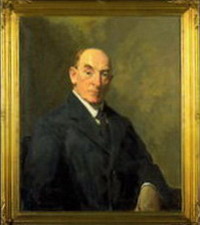
The objects that came together in 1980 as the NHC already had a history, as did their collectors and the motivations of those collectors. What is interesting are the stories such collections can jointly tell about Australia in different eras. While Colin MacKenzie was a vocal early advocate of 'national' vision, he would have been very surprised to discover that his anatomical specimens had ended up in a history — as opposed to a science — collection.[6] He may too have been surprised to read that I entitled this paper 'Weird and wonderful'. As a scientist on a mission, MacKenzie may not have foreseen that his 'weird' specimens might shock some viewers — including those of the twenty-first century who might find dissociated body parts and bottles of 'freak' abnormalities abhorrent. In his day, they were simply wonderful science.
How can bottles of body parts tell the history of a nation? This is the challenge offered to curators of the NHC's oldest collection.[7] To understand how the objects frame national histories requires an understanding of how they came to the collection, why they were collected and what earlier historical uses were made of the collection — in both science and society. I also explore what these objects can tell us about museum practice and the changes (and constancies) in national imaginings since the early twentieth century.
Most of the jars contain marsupials, monotremes and anatomical anomalies of all sorts of animals (including humans). Some are no longer considered suitable for public display, and have been on long-term loan to university anatomy departments.[10] MacKenzie gathered bodies and body parts of animals of all sorts with additional organs or other anatomical curiosities. Aborted foetuses provided evidence of abnormalities such as hydrocephaly. He also collected and received skulls — human as well as other animals. He was interested in the exceptional and what it could tell an anatomist or surgeon about the 'normal', and the evolution of 'advanced' forms. Although most of his surgery concerned bones, the majority of his anatomical specimens were chosen for what they might reveal about 'primitive' forms and body-systems, and what they could tell about an evolutionary story.
MacKenzie's view that the marsupial and monotreme fauna of Australia were 'primitive' or evolutionarily more poorly adapted than the placental mammals of the northern hemisphere was not unusual. Professor Baldwin Spencer at the University of Melbourne, for example, also assumed they were ultimately destined for extinction, because they had not been able to develop full 'lacteal gestation' (like the Eutherian forms) and had been prevented by 'some dominant factor in their germ cells ... from passing beyond the marsupial stage'. These 'very distinctive' animals 'evolved within the limits of Australia itself, indicating the complete isolation of the Continent for long ages'.[11] Because these animals were 'primitive' and were seen as displaying arrested or 'medieval' development, they were expected to fade away, to be displaced by the fitter and more 'modern' species introduced by European Australians. Extinction was 'inevitable' under this world view. The primitive fauna and flora were something colonial Australians were often uncomfortable about, perhaps fearing that they too might degenerate to a less civilised state in such a land.[12] There was very little celebration of the adaptability of the biota to Australian conditions — partly because the conditions themselves were regarded as anomalous and challenging. Even in a poem as celebratory as Dorothea Mackellar's famous My Country (1904), Australia is a 'wilful' land of 'droughts and flooding rains', and the whole first stanza is devoted to the 'normal elsewhere' of England.
It was often visitors, rather than locals, who articulated theories of Australia's primitive. For example, Joseph McCabe's contribution 'Australia — A museum of living antiquities', in the Lone Hand of November 1910, was billed as 'a scientific article by the celebrated English author and lecturer showing how primitive animals and plants of the past found refuge of this isolated island-continent'. McCabe saw Australia as one of nature's museums, a place 'where primitive types of life may retain their old-world ways, sheltered from the bustling competition of a younger and more forward generation'.[13] This idea of the primitive was perhaps most especially applied to Australian Aboriginal people, and the 'silence' about Indigenous people is now well-documented. But ideas about the primitive in animals and plants often went alongside these deeply racist assumptions and naïve ideas of evolutionary 'progress'. This was the case for both Joseph McCabe and Colin MacKenzie. MacKenzie was proud of his own 'red hair and Celtic skull', and arranged his other skulls, particularly the Aboriginal ones, accordingly 'lower' in the evolutionary sequence.[14] McCabe's Lone Hand article finishes with an unnerving climax:
For tens of thousands of years [the Australian Aboriginal], like the animals and plants about him, is preserved in the great museum from the stimulating pressure of competition. At last brain development makes vast strides, the white men fly over the seas, and on the broad face of the old continent is written the new and revolutionary motto: 'Advance Australia'.[15]
I am the Ornithorhynchus Paradoxus ... Now tell me, little Human, are you going to write a book about me? Because if you are, I'm off. I can't stand any more books being written about me; I've been annoyed enough that way ...MacKenzie, like Ethel Pedley and Joseph McCabe, saw the primitive everywhere in Australia, and the land itself as a continental museum. McCabe described it as 'a place of refuge for mediaeval types from the pressure of a turbulent rising generation'.[18] MacKenzie was more inclined than the others to sell its exceptionalism as an advantage, both at home and abroad.
See, for instance, the way you have all quarrelled and lied about me! One great Human, the biggest fool of all, said I wasn't a live creature at all, but a big joke another Human had played upon him. Then they squabbled together — one saying I was a Beaver; another a Mole, or a Rat. Then they argued about whether I was a bird, or an animal, or if we laid eggs or not; and everyone wrote a book, full of lies, all out of his head ...
Humans are so ignorant! That is because they are so new. When they have existed a few more million years, they will be more like us old families ... Humans and Wagtails fraternise together. They're both post-glacial.[17]
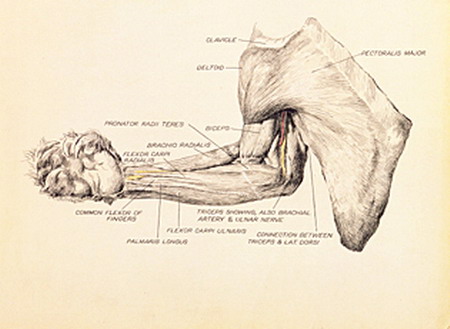
Artwork: Victor Ernest Cobb; photo: George Serras
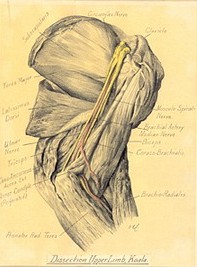
The collection, which will form the nucleus of an Institute of Zoology to be established later at Canberra, is one of the finest in the world ... As the value of the collection lies more in its historical interest — which is undoubtedly great — than in its importance as an aid to medical science ... [A]t a time when our fauna is rapidly becoming extinct, and the collection of representative specimens is becoming increasingly difficult, [this donation] constitutes an act of practical patriotism the merit of which it would be hard to over-estimate.[22]MacKenzie used the collection's 'national interest' to broaden his own scientific base. He did not want to be limited to 'medicine', but sought to contribute more broadly to zoology, at a time when science was very much on the national agenda. George Currie and John Graham have described it as a 'dramatic period', when 'scientists and men of vision convinced the political leaders of their day that scientific discovery could render valuable service to their developing country'.[23] Yet Pearce, the politician, missed this dimension and instead chose to focus on the MacKenzie collection's national historical interest. Extinction was forever — and it was this that captured political attention. Under the terms of the Zoological Museum Agreement Act 1924 the MacKenzie collection was earmarked for the national capital, and its collection of specimens 'of a value without price ... when live specimens are not obtainable' shaped discussions about a possible national museum of zoology.
The most intellectual [of all mammals], erect man alone possesses the prefrontal brain, associated with which is the development of the characteristic human forehead.[25]Having established the 'superior humanity' inherent in an erect posture, MacKenzie then nationalised it:
Probably no game in the world exercises the erect posture functions more than the Australian game of football. It is founded on sound physiological lines and has been no small factor in the physical development of our nation.[26]MacKenzie invoked a progressive philosophy that intertwined claims for intelligence, utilitarianism and the popular national sport. He was also interested in improving the design of the human body itself, as his work on the koala shoulder showed, and thought it appropriate to display such knowledge in a national museum.
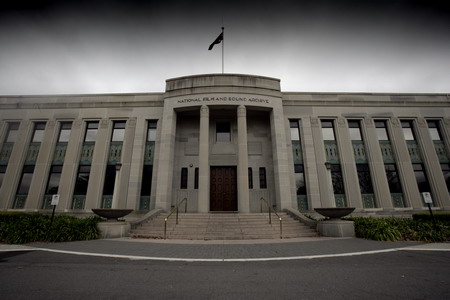
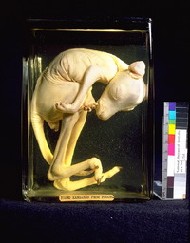
The early displays were attractive and accessible to the general public. A rare example of an early visitor's experiences, Norman Wettenhall's recollections of visiting the AIA within a year or two of its opening reveal that the teenager was deeply impressed. The sheer volume of specimens must have been overwhelming. There was a 'platypus island' in the middle of the gallery that contained some 400 specimens, including comparative material.[33] There was little accommodation for visitors in Canberra at the time and Norman remembered camping with his father and brother in Acton, right near the AIA.[34] More than six decades later, he could describe in detail the tall glass jars at the AIA and their amazing contents. In this rather formal and sacred gallery of research, purpose-built out of beautiful materials for these objects, the 'wonderful' transcended the 'weird'.
The range and number of the collections on display also impressed Markham and Richards. They praised the fact that the collections were connected to a strong research agenda, contrasting this with the Australian state museums in this era, which were overshadowed by the fiscal restraints of a major depression. The AIA's Northern Gallery featured in the first of very few photographic plates in their report, and the caption described it as 'primarily a research institution'. In their 1934 directory they went further, noting that it 'constitutes the first unit of the intended National University of Australia' for Canberra.[35]
The AIA changed greatly after MacKenzie's death in 1938. Its basements, carefully built by MacKenzie for future anatomical collections, were filled with the displaced national ethnological collections of Sydney University anthropologist Alfred R Radcliffe-Brown, who had worked as advisor to the Commonwealth on Aboriginal people in far north Queensland, and in the territories of Papua and New Guinea. MacKenzie had taken up the cause of 'ethnological' work himself in the 1930s, albeit with an anatomical bias. Throughout the 1930s he supported George Murray Black, a farmer and hobby-collector, in collecting not just stone tools, but 'aboriginal specimens' as well. Black dug up Aboriginal skeletons from burial mounds along the Murray River between 1929 and 1950, 1600 of which were eventually presented to the AIA.[36] Bodies and tools lay side by side, unsorted, in the basement of the AIA, to the increasing embarrassment of curators charged with their care. Many of the materials from other states were returned to state museums, if their origins could be identified. However, collections regarded as 'national' — especially those from northern Australia, New Guinea and Papua — remained in the AIA building.[37] Many of the earliest ethnological collections of the 1920s languished in its basement, over time losing their labels to silverfish and neglect. The state of these collections was one of the reasons for a new review of national collections, instigated in 1974.
to advise on the scope, objectives and functions of an Australia Institute to develop, co-ordinate and foster collections, research and displays of historical, cultural and scientific material of national significance, giving particular attention to its relationship with the Government and other institutions.[38]The scope of this far-reaching inquiry was shaped by other reformist ventures, government and otherwise, that were happening in parallel in history, heritage and Aboriginal studies. History was becoming more concerned with its material aspects, and with what should constitute the national 'estate'. National collections were extending to include places which could be valued for 'natural' or 'cultural' significance.[39] The Pigott Committee 'experts' included two historians, Geoffrey Blainey and John Mulvaney, and scientists Douglas Waterhouse, Bill Boswell and Frank Talbot. Just fifteen years earlier, an inquiry into national collections initiated by the Royal Society of Canberra had been entirely about scientific collections and their research and management; this inquiry had included neither humanities experts nor business leaders.[40]
Mulvaney was at the forefront of developments in Aboriginal studies. He was an archaeologist and a council member of the Australian Institute for Aboriginal Studies, who had advocated a Project Coordination Committee on Historical Archaeology to advise on new national collecting ventures. The Pigott Committee reported in 1975, during a period of significant changes in attitudes and policies towards Australia's Indigenous population. In that year, Prime Minister Gough Whitlam famously restored a handful of sand to Gurindji elder Vincent Lingiari, with the words 'I put into your hands part of the earth itself as a sign that this land will be the possession of you and your children forever'.[41] Indigenous studies had moved from studying Aboriginal people as 'scientific subjects' to 'subjective voices'. Stone tool collections, gathered in very different eras, were no longer understood as taxonomic assemblages, but rather as cultural artefacts. Aborigines were no longer 'science' but 'humanities'. Cultural and political sensitivities about Aboriginal people were emerging belatedly and, after years of silence, finding a voice. Such rethinking raised new questions for those ethnological collections in the basement of the AIA. Human remains (especially those of people recently passed away, such as MacKenzie had urged for collection in the 1920s and 1930s), were now a serious embarrassment.[42]
The Pigott Committee used its broad terms of reference to review the conservation and storage of collections. It found them to be generally very poor — not just at the AIA, but in the National Library of Australia, the National Gallery of Australia and the Australian War Memorial. It also explored the possibilities for new national collections and established the framework for what became the National Historical Collection. But the old division between science and 'the rest' was perpetuated when Douglas Waterhouse, chief of the Division of Entomology at the Commonwealth Scientific and Industrial Research Organisation (CSIRO), submitted a minority report at the eleventh hour. In it he recommended that 'Collections in Natural Science' should be outside the remit of the proposed new Museum of Australia and made the responsibility of 'the Interim Council of the Australian Biological Resources Study'.[43] This recommendation did not include the MacKenzie collection, which remained with the AIA — therefore effectively defining them as 'not natural science'. The National Museum of Australia Act enabled the Museum to 'develop and maintain a national collection of historical material' and to research 'matters pertaining to Australian history'.[44] The Pigott Committee had actually recommended that:
the theme of the Museum be the history of man and nature in this continent, their linked roles and their interactions.[45]But apart from the AIA collections, the Museum had to do this without 'natural science', which had been extracted from the national collections by Waterhouse's deft manoeuvre. The committee had written that 'to divorce man from nature in the new museum would be to perpetuate a schism which the nineteenth century, in the interests of science, did much to foster'.[46] It was one of the great ironies that in the interests of twentieth-century science Waterhouse did it again, single-handedly, right under the noses of the committee. Only the MacKenzie collection and associated material remained for the NHC, an accidental oversight (or perhaps by then, Waterhouse thought them to be 'unnatural science').
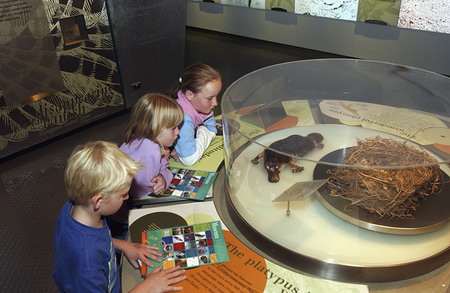
When the curators and designers of the new museum were charged, prior to its opening in 2001, with finding national stories about people and the environment, the general lack of scientific collections was a serious problem. The MacKenzie collection was suddenly deemed to be important and relevant again. One of the international designers, Matt Kirchman from Boston, wanted to open the gallery with an 'exploding wall' of strange animals, even more strangely preserved in glass bottles. This proved too difficult in terms of logistics and conservation. However, momentum gathered for the idea of a 'strange nature' module to open the people and environment gallery, later called 'Tangled Destinies' and recently renamed 'Old New Land'. The module currently on display would not have been possible without the platypuses and nests collected, not by MacKenzie himself, but by Harry Burrell, the self-confessed 'platipoditudarian', and presented to MacKenzie for the AIA museum.
In the final years of the twentieth century, the international designers of the National Museum of Australia seized on Burrell's platypus nests — some with eggs and others with model young — as the key 'first object' for visitors to the new museum in 2001. Such was the 'pulling power' of this material that on opening day, a platypus nest and eggs were the centrepiece of an 'island' display in the Tangled Destinies gallery about the strange and contrary platypus. Unknowingly, the Boston designers had echoed the platypus island display in the first AIA gallery in 1931.[47]
This paper has been independently peer-reviewed.
2 The Australian Museum was founded in either 1827 or 1829, depending on your point of view — as discussed in Ronald Strahan, Rare and Curious Specimens: An Illustrated History of the Australian Museum 1827–1979, Australian Museum, Sydney, 1979, pp. 7–14. On Melbourne's Museum Victoria (as it is now known) see Carolyn Rasmussen (together with 46 specialist contributors), A Museum for the People: A History of Museum Victoria and its Predecessor Institutions, 1854–2000, Scribe Publications with Museum Victoria, Carlton North, Victoria, 2001. See also Libby Robin, 'Collections and the nation: Science, history and the National Museum of Australia', Historical Records of Australian Science, vol. 14, no. 3, June 2003, pp. 251–89.
3 Ian McShane, 'Building a National Museum of Australia: A history', Public History Review, vol. 7, 1998, pp. 75–88, especially pp. 76–78.
4 Anne-Marie Condé, email to Libby Robin, 26 February 2006.
5 WC MacKenzie, The Comparative Anatomy of Australian Mammals, 4 vols, C Parker, Melbourne, 1918–1919.
6 On 'national' aspirations, note that MacKenzie called his personal collection, before it even left Melbourne, the Australian Institute of Anatomical Research (from 1919). See Monica MacCallum, 'Sir William Colin MacKenzie (1877–1938)', in Australian Dictionary of Biography, ed. by Bede Nairn and Geoffrey Serle, vol. 10, 1891–1939, Lat–Ner, Melbourne University Press, Carlton, 1986, pp. 306–8, especially p. 307.
7 Much of this paper draws on Libby Robin, 'A report on the historical, cultural and biological significance of the National Historical Collection's MacKenzie wet specimens', June 2005 (unpublished report commissioned by Guy Hansen, Senior Curator, National Museum of Australia), but sets aside some of the interesting issues raised by conservators managing the century-old wet specimens: debates about which solutions, and which seals, and how often solutions need to be changed that filled three of the thickest files I reviewed in my research on the collection. (The key conservation files were 86/598; 98/0047; 98/0183 and they span 1984 to the present.)
8 Report of the Parliamentary Standing Committee on Public Works on the 'National Museum of Australian Zoology, Canberra', chaired by GH Mackay (hereafter the Mackay report), Australian Archives A1818/3, Item 18, barcode 139729. See p. vi for quote about 'without price'. Valuation based on offers from United States.
9 Extremely fragile, the thylacine was most recently displayed in the National Museum of Australia's Captivating and Curious exhibition in 2005–2006. See also Guy Hansen (ed.), Captivating and Curious (with an introduction by Robert Edwards), Canberra, National Museum of Australia Press, 2005.
10 For example, the 'war wounds collection' obtained from 1916–1918 AIF soldiers was first donated to the University of Melbourne, then in 1933 returned to the AIA. In 1996 there were discussions about transferring the collection to the University of New South Wales Forensic Science department, but it was finally placed with the Australian War Memorial. There have also been negotiations for human remains in the collection to be transferred to the Australian National University medical school. See National Museum of Australia conservation files 89/0037; 96/0527.
11 Sir Baldwin Spencer, 'Presidential address to the Australasian Association for the Advancement of Science', in Report of the Fifteenth Meeting of the Australasian Association for the Advancement of Science: Hobart Meeting held in Melbourne January 1921, ed. by Georgina Sweet and ACD Rivett, AAAS, Sydney, 1921, pp. liii–lxxxix, quotes pp. lxxxvii, lxxvi–lxxvii.
12 Anxiety about degeneracy is explored by Warwick Anderson, The Cultivation of Whiteness: Science, Health and Racial Destiny in Australia, Melbourne University Press, Carlton South, 2002. See also David Walker, Anxious Nation: Australia and the Rise of Asia 1850–1939, University of Queensland Press, St Lucia, Qld, 1999.
13 Joseph McCabe, 'Australia — A Museum of Living Antiquities', Lone Hand, 1 November 1910, pp. 38–46, quotes p. 38. I am grateful to David Kaus for drawing my attention to this reference.
14 'Red hair and Celtic skull' was a self-descriptor noted by MacKenzie's biographer, Monica MacCallum, in 1984 (MacCallum archive, National Museum of Australia, series 5/1).
15 McCabe, 'Australia', p. 46.
17 Pedley, Dot and the Kangaroo, pp. 21–23.
18 McCabe, 'Australia', p. 44.
19 JHL Cumpston, 'Human disease in Australia — a history', unpublished manuscript (photographed by JS Cumpston, 15 November 1965), in National Museum of Australia MacCallum archive, series 8/2.
20 WC MacKenzie, The Treatment of Infantile Paralysis: A Study on Muscular Action and Muscle Regeneration, Stillwell, Melbourne, 1910, especially 'Treatment of upper extremity', pp. 57–72.
21 See Professor Colin MacKenzie, 'The medical importance of the native animals of Australia', document circulated to Members of Parliament, Government Printer, Melbourne [1930]; also Monica MacCallum, 'Sir William Colin MacKenzie'. This story of taking the koala's shoulder to London has had great appeal for museum curators. It appeared at various times in the displays of the AIA. Evidence for the museological use of the story comes from photographs of Cobb's drawings of koala shoulder material and correspondence in the early 1980s. See correspondence between Robert Edwards (Director of AIA) and the graphic designer Nicholas Summers, MacKenzie library collection, National Museum of Australia Library. Several of the Cobb images have pinholes in the corners, so they were removed from the large folio books for display at some stage.
22 Commonwealth Parliamentary Debates (CPD), 16 August 1923, vol. 105, p. 2839. The legislation passed as the Zoological Museum Agreement Act (no. 49 of 1924), and was later subsumed by the Australian Institute of Anatomy Agreement Act 1924–1933.
23 Sir George Currie and John Graham, The Origins of CSIRO: Science and the Commonwealth Government 1901–1926, CSIRO, Melbourne, 1966, p. v. The period they were referring to was 1916–1926, after the WM Hughes Government established the Advisory Council of Science and Industry, and leading up to the establishment of the Council for Scientific and Industrial Research (CSIR) in 1926.
24 Wm Colin MacKenzie, 'The importance of zoology to medical science', in Proceedings of the Australasian Association for the Advancement of Science, ed. by Clive E Lord, vol. 19, Government Printer, Hobart, 1929, pp. 235–42.
25 MacKenzie, 'The importance of zoology to medical science', p. 237.
26 ibid., p. 241.
27 'Minutes of evidence', attached to the Mackay report, 18 February 1927, p. 1.
28 The Australian War Memorial was built in Canberra in 1941. An 'Australian War Museum' opened on ANZAC Day 1923 in the Exhibition Building, Melbourne, and remained open there until 1925 when it was moved to Sydney, where it remained until 1935 when the material was placed in storage for the Canberra museum. See Australian War Memorial website, http://www.awm.gov.au/aboutus/origins.htm (accessed 17 March 2006).
29 The Mackay report estimated the cost of the proposed building, including the reservation and associated residences at £87,080 in 1927. In 1933, after the buildings were completed, Sydney Markham and HC Richards in A Report on the Museums and Art Galleries of Australia and New Zealand, McCorquodale and Co. Ltd, Wolverton, Bucks and Museums Association, London, 1933, estimated the cost at £100,000, which is probably closer. MacKenzie's contributions to this amount are not formally documented, but his personal supervision of the building works, the attention to detail in the stone masonry (including the detailed Australian animals depicted in the gargoyles and other expensive features) along with the official sponsorship, for example of the annual oration (£1000, each year, in memory of his mother), suggest a very significant personal contribution, particularly in the Depression years of 1929–1930.
30 The building now houses the National Film and Sound Archive.
31 This reserve later became Tidbinbilla. The argument for the reserve was that it was important for perpetuating the field station work MacKenzie had begun at Healesville in 1920, but in fact this area was not developed until later.
32 Markham and Richards, A Report on the Museums and Art Galleries, p. 2.
33
Auditor-General's Report, 1932–33, Item 38AIA, Vicars St Repository, National Museum of Australia, pp. 22–23.
34 Transcript of personal communication with Norman Wettenhall (1915–2000), interview 2, 19 March 1998, p. 9.
35 Markham and Richards, A Report on the Museums and Art Galleries, p. 30.
36 Tom Griffiths, Hunters and Collectors: The Antiquarian Imagination in Australia, Cambridge University Press, Cambridge, 1996, p. 81. These 'collections' were authorised by the National Museum of Victoria and shared between the Institute of Anatomy and the University of Melbourne.
37 For a recent account of the Official Papuan collection, see Sylvia Schaffarczyk, 'Australia's Official Papuan collection: Sir Hubert Murray and the how and why of a colonial collection', reCollections: Journal of the National Museum of Australia, vol. 1, no. 1 (2006), http://recollections.nma.gov.au/
issues/vol_1_no_1/papers/the_papuan_collection/.
38
Museums in Australia 1975: Report of the Committee of Inquiry on Museums and National Collections, chaired by PH Piggott (henceforth the Piggott report), AGPS, Canberra, 1975, p. 1.
39 The Australian Heritage Commission was established in 1975. The Report of the National Estate was published in 1974.
40 See Robin, 'Collections and the nation'.
41 For the Lingiari story, see http://www.nlc.org.au/html/land_hist.html (accessed 22 March 2006).
42 The oversight of the repatriation of human remains is one of the inherited responsibilities of the new National Museum of Australia, and this institution is the only place in Australia that can receive repatriated human remains from international museums and other institutions.
43 Pigott report, Section 8.40, p. 48. For more detail about this sleight of hand, see Robin, 'Collections and the nation', pp. 275–79.
44
National Museum of Australia Act 1980, Section 6 1(a) and (c).
45 Pigott report, section 12.6, pp. 70-1.
46 ibid.
47 I was a member of the curatorial team in 1999 when these ideas were discussed. The observation about the platypus island at the AIA in 1931 was made much later, in 2005, when I came across the 1932–33 Audit list in Item 38AIA, at the National Museum of Australia's Mitchell Repository, in the course of a consultancy undertaken for the Museum. There is evidence that platypus 'islands' appear in nineteenth-century museums as well. See image of the Queen Victoria Museum, Launceston, reproduced in Sally Gregory Kohlstedt, 'Australian museums of natural history: Public priorities and scientific initiatives in the 19th century', Historical Records of Australian Science, vol. 5, no. 4, 1983, 1–29, image p. 14.
